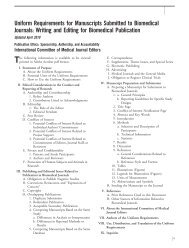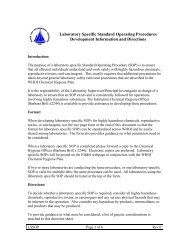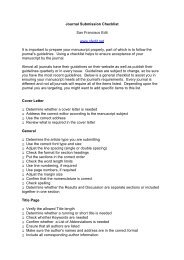Guidance for Preparing Standard Operating Procedures (SOPs)
Guidance for Preparing Standard Operating Procedures (SOPs)
Guidance for Preparing Standard Operating Procedures (SOPs)
You also want an ePaper? Increase the reach of your titles
YUMPU automatically turns print PDFs into web optimized ePapers that Google loves.
Data ML005<br />
Rev. # 0.0<br />
Date: 11/00<br />
Page 11 of 16<br />
high solids samples or per<strong>for</strong>m an analytical spike to demonstrate that<br />
solids are not causing an interference. The analysis SOP should give<br />
guidance regarding when such is necessary.<br />
7.1.2 Chemical Interference: GFAA compensates <strong>for</strong> chemical interferences by<br />
using the analytical spike to verify that they are not causing interference.<br />
ICP can have ionization interference when, <strong>for</strong> example, a high sodium<br />
concentration provides excess electrons, permitting more neutral atom<br />
species <strong>for</strong> potassium, thereby biasing potassium high.<br />
7.1.3 Spectral Interference: All spectral techniques are prone to interference,<br />
either from fluctuating background, spectral overlap, or isobaric overlap.<br />
The expected interferences are built into correction algorithms in the<br />
instrument method. The analyst and peer reviewer should be aware of the<br />
limitations of those correction algorithms and what evidence might indicate<br />
those limitations have been exceeded. For example, the presence of a result<br />
that is very negative <strong>for</strong> one analytical line in ICP analysis may be an<br />
indicator that an interferent is present in the sample that is not included in<br />
the IEC table or MSF model. Alternate lines can be used to verify the<br />
results obtained. An additional spectral interference that is unlike the usual<br />
overlap is possible with the X instrument: subarray saturation. It is<br />
possible that as the subarray is integrated using variable integration time,<br />
that another line on the subarray other than the one being analyzed <strong>for</strong> is<br />
much larger, thereby cutting short the integration time <strong>for</strong> the analyte and<br />
raising the detection limit <strong>for</strong> that line.<br />
7.1.4 As sometimes occurs in multi-analyte techniques, dilution may be necessary<br />
to obtain a valid result <strong>for</strong> one constituent, but the presence of that<br />
constituent may or may not affect the analysis of the other analytes. It is<br />
desirable to provide as much in<strong>for</strong>mation to the end user of the data as<br />
possible. It is valid to report some data from one dilution, while reporting<br />
other data from a lesser dilution or even the undiluted sample. If the effect<br />
of the high level constituent is merely a physical effect on sample delivery,<br />
and it can be shown that the analytes that are above the reporting level both<br />
be<strong>for</strong>e and after the dilution are the same within expected error, then all the<br />
trace analytes may be reported from the lesser dilution. If the sample were<br />
spiked, direct evidence of the physical interference can be obtained. For a<br />
spectral interference, this is not conclusive evidence, so an evaluation of<br />
the relative error in each case, as determined from the IEC table (if used),<br />
is needed.<br />
QA/G-6 E-11<br />
March 2001







